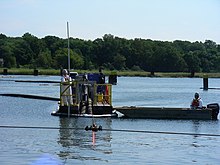
Back إصلاح بيئي Arabic Sanace (ekologie) Czech Remediación Spanish Maa-ala tervendamine ET پاکسازی زیستمحیطی FA Dépollution French Санација на животната средина MK Pemulihan alam sekitar Malay Despollucion OC Remediacja Polish
This article needs additional citations for verification. (April 2021) |

Environmental remediation is the cleanup of hazardous substances dealing with the removal, treatment and containment of pollution or contaminants from environmental media such as soil, groundwater, sediment.[1] Remediation may be required by regulations before development of land revitalization projects. Developers who agree to voluntary cleanup may be offered incentives under state or municipal programs like New York State's Brownfield Cleanup Program. If remediation is done by removal the waste materials are simply transported off-site for disposal at another location. The waste material can also be contained by physical barriers like slurry walls. The use of slurry walls is well-established in the construction industry. The application of (low) pressure grouting, used to mitigate soil liquefaction risks in San Francisco and other earthquake zones,[2] has achieved mixed results in field tests to create barriers, and site-specific results depend upon many variable conditions that can greatly impact outcomes.[3][4]
Remedial action is generally subject to an array of regulatory requirements, and may also be based on assessments of human health and ecological risks where no legislative standards exist, or where standards are advisory.[5]
- ^ "Understanding Remediation". NYC Economic Development Corporation.
- ^ "Liquefaction Remediation Near Existing Lifelines ]page=28" (PDF). NIST.
- ^ "A field test of permeation grouting in heterogeneous soils using a new generation of barrier liquids". US Department of Energy Office of Science and Technical Information (OSTI).
- ^ "Grouting Techniques in Bottom Sealing of Hazardous Waste Sites". EPA.
- ^ Watts, Ryan (2019-10-22). "Environmental Diligence Home Builders Must Follow Before Building". nedstevens.com. Retrieved 2021-01-28.